What is trace and soap? Trace is the time when the saponification of the lye, water, and oils have become soap. It is at this stage when the soap base is thicker and doesn’t start to separate if you stop stirring. It will continue to get thicker from here on in. Now is also the time to add your scents, colorants, superfats, clays, or anything else, then you’d pour all this into the molds.
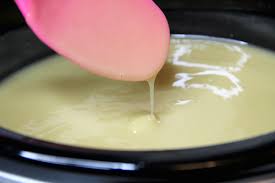
When I started making soap I kept thinking What is trace in Soap Making? It sounded complicated to me, but once I saw it, I knew what it meant. I have given you step by step instruction on how to make soap, but here is some more information to help you clearly understand TRACE.
What is trace in Soap making?
Trace is when the chemistry of the water and oils starts working to create a soap-like substance. When a real trace has occurred your lye solution and oils will not separate anymore, the emulsion of the oils and water, with the chemical reaction from the lye has fully blended and will continue to set up or become solid. While this process is occurring the pH levels of the lye are being neutralized, so in the end, you will have a gentle cleaning bar.
The signs of trace are:
- the soap has changed color a little, a lighter shade
- the oil layer is not visibly sitting on top
- the soap base has gotten thicker
- the soap doesn’t separate if you stop stirring
- if you pick up the spoon and drizzle soap on top, it does not sink right in, it will sit on top
- although sometimes it will sit on top and then slowly become one with the soap again
This is the perfect photo of trace:
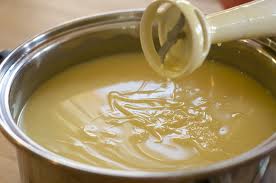
You can stir with a big wooden spoon to get this effect, but a hand blender will speed up the process. Just be careful not to bring the blade action too close to the top and get spattered. (a caustic liquid splash will burn) Be sure to wear your protective apron, safety glasses, and gloves.
What is trace and soap, and a series of images to show the progress from oils and lye water to a soap:
1. The first image shows that the lye and water have been added, and some stirring has occurred, but you can still see that the oils are sitting on the top.
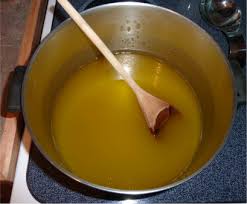
2. The second image shows the stick blender/hand-blender mixing the oils and lye water. At this point, the oils would still separate and sit on top.
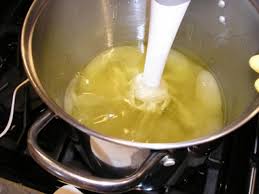
3. The third image shows a finished soap base, you can tell by the color that it isn’t separating, and now a superfast is being added.
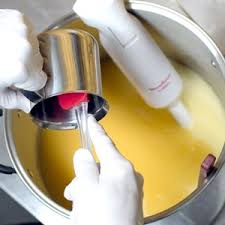
4. the fourth image is your soap in a mold. This soap appears darker, and soap will change color a little, for instance, an all olive oil soap will be darker than say a canola and coconut oil soap would be.

When your soap has traced
At this point, your soap is soap, all-natural unscented, and uncolored. Now is when you would add your additives and pour your soap into molds. The stick blender increases the time of trace, without it you could be stirring for a long time. Stir in your final additives and use the stick blender to mix them in well, then pour your soap into molds, and yes scrap the sides of your pot….you don’t want to leave a bar or two behind.
It is better to over-trace than under. In theory, if your soap is under traced, it may try and separate which could leave you with a harsh lye-strong soap on the bottom of your mold and a layer of oil on the top.
If you over-trace, this just means your soap will be thicker which is fine, the only problem with this may be if you are adding essential oils or other additives as it may be harder to bend them in, and you may end up spooning your soap into the mold. (Some people prefer to spoon it in)
Leave the “what is trace” page and check out what ‘superfatting’ your soap is.
Find out exactly what lye, aka caustic soda, aka sodium hydroxide, is here at Wikipedia.
#handmadesoap #naturalsoap #makinsoapnaturally #soapmaking #soapmaking #soaps #artisansoap #bathandbody #cpsoap #coldprocesssoap #etsy #soapbase #soapcrafter #soapmaker #soaping #soapcrafting #soaphandmade #soap #giftidea #christmas #barsoap #handmadesoap #natural #organic #skincare #coldprocess
© 2023 – 2024, Tes. All rights reserved.